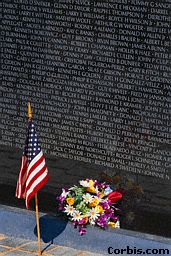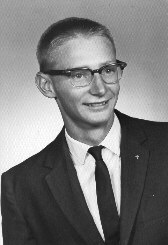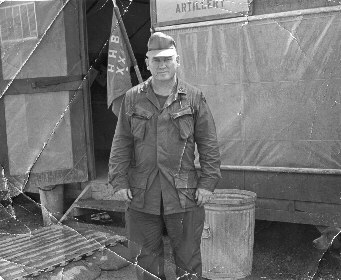ORIGINS
NAME INDEX
FAMILY HISTORIES
FAQS
COAT OF ARMS
NEWSLETTER
MESSAGE BOARD
HONOR ROLE
LINKS
 Click on one of the items below for a summary of the war or a short biography about one of our Coulthart ancestors/descendants who served during this conflict.
Click on one of the items below for a summary of the war or a short biography about one of our Coulthart ancestors/descendants who served during this conflict.
- Summary of the Vietnam War
- Gerald Frank Coulthart 1947-1969
- Larry Wayne Coulthart 1948-1998
- Raymond R. Coulthart 1946-1973
- Robert E. Coulthart 1848-1998
- Holger Johnson
- John Charles Meinke 1930-present
- Bibliography
- Return to the Coulthart Honor Role
Summary of the Vietnam War
"The Vietnam War was a struggle fought from 1959 to 1975. It began as a determined attempt by Communist guerrillas (the so-called Vietcong) in the South, backed by Communist North Vietnam, to overthrow the government of South Vietnam. The struggle widened into a war between South Vietnam and North Vietnam and ultimately into a limited international conflict. The United States and some 40 other countries supported South Vietnam by supplying troops and munitions, and the USSR and the People's Republic of China furnished munitions to North Vietnam and the Vietcong. On both sides, however, the burden of the war fell mainly on the civilians."
"The war intensified in 1960, the year in which North Vietnam proclaimed its intention 'to liberate South Vietnam from the ruling yoke of the U.S. imperialists and their henchmen.' U.S. economic and military assistance to the South Vietnamese government increased significantly and in December 1961 the first U.S. troops, 400 uniformed army personnel, arrived in Saigon." A year later, U.S. military strength in Vietnam stood at 11,200 and by 1969 it peaked at over 541,000. Although 1,766,910 men were drafted during the Vietnam War, not all of them served in Vietnam. "Unlike conventional wars, the war in Vietnam had no defined front lines. Much of it consisted of hit-and-run attacks, with the guerrillas striking at government outposts and retreating into the jungle," followed by search and destroy missions by the U.S. and South Vietnamese armies. To many, it was a war in which the enemy was at times difficult to identify.
"In the United States, as military involvement increased, the war became increasingly controversial." The Vietnam War was the first in which live footage, showing the horrors of war, was broadcast on national television, bringing the war to the masses. "A peace movement developed and gathered momentum, organizing marches and moratoriums against the war. In addition, a major reinterpretation of U.S. involvement in the war was spurred by the controversial publication in 1971 of the so-called Pentagon Papers. This collection of classified U.S. government documents cast a new, and to many, a dismaying light on the U.S. handling of the war and of the peace negotiations through the 1960's."
"On January 27, 1973, in Paris, delegations signed an agreement ending the war and restoring peace in Vietnam. By the end of March 1973, all U.S. fighting forces had been withdrawn. Although President Nixon had apparently assured the South Vietnamese government that U.S. forces would step in to support them in the event of a major treaty violation, further military assistance to South Vietnam became politically impossible. One of the reasons for this was the concurrent outbreak of the Watergate scandal. Fighting between Vietnamese antagonists renewed and on April 30, 1975, the capital of Saigon was captured and South Vietnam surrendered unconditionally to the communist North."
One out of every 10 Americans who served in Vietnam was a casualty. "Less measurable but still significant costs were the social conflicts within the U.S. that were engendered by the war – the questioning of U.S. institutions by the American people and a sense of self-doubt."
Unlike their portrayal by the media and in the movies, the majority of veterans of the Vietnam conflict were much like their counterparts from previous wars. They may not have wanted to go to Vietnam, but they did so out of a feeling of duty for their country. They were the unfortunate victims of an unpopular war, a war in which success was difficult to measure. There were few ticker tape parades when they came home and little thanks for their sacrifice. Vietnam was the most prolonged conflict ever fought by America GI's.
|
Country |
Mobilized |
Fatalities |
Wounded |
|
U.S. |
2,590,000 |
58,169 |
304,000 |
Of those wounded, 75,000 were disabled. What follows are the stories of our Coulthart relatives or their descendants who served during this conflict.
All of the sentences in the above summery enclosed in quotes were taken verbatim from Microsoft's Encarta Encyclopedia.
Return to top of pageLarry Wayne Coulthart (1948-1998) Spec 5, U.S. Army Support Command-516th Personnel Service Company
Larry was born in Grafton, North Dakota in 1948. He was the son of William Coulthart and Mardith Nelson. In 1962, when Larry was 13 years old, his father passed away. Larry continued to work the family farm with his mother. He graduated from Grafton High School in 1966. After graduation, he continued farming until he turned 21. He was inducted in the Army in February 1970. During the period from October 1970 to October 1971 he was stationed with the U.S. Support Command in DaNang, Vietnam. He served in the DaNang area of operations under continual hostile action and was awarded the Letter of Commendation, the Good Conduct Medal, the Army Commendation Medal and the Bronze Star for meritorious achievement in ground operations against a hostile force. He received an honorable discharge in 1972.
After his discharge Larry returned to Grafton and began a successful farming career on the family farm raising small grains and sugar beets. In 1974 he married Frances Boulduc and the couple had two children: Tina (1972) and Rachel (1980). Larry farmed until he unexpectedly passed away of a heart attack in 1998, at the age of 49. Larry was the great grandson of Walter Coulthart (1820-1892) of Grafton, North Dakota.
Return to top of pageGerald Francis Coulthart (1947-1969) Spec 4, U.S. Army B Battery, 1st Battalion, 30th Artillery 1st Cavalry Division (Air Mobile)
Click on Gerald's name to learn more about this relative who was killed in action in Vietnam.
Return to top of pageRaymond R. Coulthart (1946-1973) U.S. Army
 Raymond was born in 1946 near Hamilton, North Dakota. He was the son of Raymond Coulthart and Louise Lambrecht. During the Vietnam Era, Raymond served in the army and was stationed in Germany. His younger brother Gerald was killed in action in Vietnam.
Raymond was born in 1946 near Hamilton, North Dakota. He was the son of Raymond Coulthart and Louise Lambrecht. During the Vietnam Era, Raymond served in the army and was stationed in Germany. His younger brother Gerald was killed in action in Vietnam.
After his discharge, Raymond returned to the Hamilton area and died in a farm accident in 1973. He was the great grandson of Walter Coulthart (1820-1892) of Grafton, North Dakota.
Return to top of pageRobert E. Coulthart (1948-1998) U.S. Army
Robert E. Coulthart was born in June 1948. He was the son of Robert Coulthart and Gertrude Pohl. Robert served in Vietnam and passed away in March 1998 at age 49 in Arizona. Robert was the great-great-great grandson of William Coulthart (1800-1880) of Cannamore, Ontario.
Return to top of pageHolger Johnson served in WWII, Korean and Vietnam. Click on his name to learn more about him.
Return to top of pageJohn Charles Meinke (1930-present) Master Sergeant, U.S. Army
John was born in 1930 in Park Rapids, Minnesota. He is the son of Charles Meinke and Pearl Glascow. John enlisted in the U.S. Army shortly after graduation from high school in 1950. After basic training he was assigned to Ft. Hood, Texas where he married his high school sweetheart Patricia Hughes. John made the service his career and was assigned to the following duty stations during his twenty years in the service: Ft. Hood, Texas; Augsburg, Germany; Colorado Springs, Colorado; Ulm, Germany; Manhattan, Kansas; Olivia, Minnesota; Ft. Sill, Oklahoma; Karlsruhe, Germany and Buddingen, Germany. His area of expertise was field artillery.
During his career in the military, John completed two tours of duty in Vietnam. In 1963-1964 he spent a year in Vietnam as a military advisor. He was stationed with the 36th Vietnamese Artillery in Vinh Long and Can Tho, located about 50-75 miles southwest of Saigon. In mid 1964, John returned to the states and was assigned to Ft. Sill, Oklahoma, the headquarters for the United States Army Artillery. From 1964-1967 his primary responsibility was to provide advanced artillery training for soldiers scheduled to go to Vietnam.
 John in Phu Bai, Vietnam in 1969
John in Phu Bai, Vietnam in 1969
John's second tour of duty in Vietnam began in January 1969 during the height of the war. He was assigned to the XXIV Corp HQ (headquarters) at Phu Bai which was located about 60 miles south of the DMZ, 10 miles south of Hue and 50 miles north of Da Nang. John served as the Operations Sergeant, E8, for the XXIV Corp Artillery. He coordinated the combat units so that the infantry had the proper artillery support for their missions. John was cited with the Bronze Star for bravery in action. The citation reads, "By direction of the President, the Bronze Star Metal is presented to Master Sergeant John C. Meinke, United States Army, who distinguished himself by outstanding meritorious service in connection with the military operations against a hostile force in the Republic of Vietnam. During the period of January 1969 to January 1970, he consistently manifested exemplary professionalism and initiative in obtaining outstanding results. His rapid assessment and solution of numerous problems inherent in a combat environment greatly enhanced the Allied effectiveness against a determined enemy. Despite many adversities, he invariably performed his duties in a resolute and efficient manner, energetically applying his sound judgement and extensive knowledge. He has therefore contributed to the successful accomplishment of the United States mission in Vietnam. His loyalty, diligence and devotion to duty were in keeping with the highest traditions of the military service and reflect great credit upon himself and the United States Army."
John retired from the service in 1971 and currently lives in Olivia, Minnesota. John and Pat have three children: Chuck (1952), Teresa (1954) and Drake (1963). Pat is a descendant of William Coulthart (1833-1916) of Waseca, Minnesota and William Coulthart (1800-1880) of Cannamore, Ontario.
Return to top of pageBibliography
- Ground War - Vietnam Vols. 1 and 2, 1945-1968 by Jim Mesko
- Hardchargers Website at www.geocities.com/Pentagon/Bunker/1636
- The Illustrated History of Artillery - The Vietnam War by James R. Arnold
- Induction Statistics - www.sss.gov/induct.htm
- Microsoft Encarta Encyclopedia - Vietnam War history
- Military Records from National Personnel Records Center (Military Personnel Records) in St. Louis, MO,
- The Wall information - www.no-quarter.org

